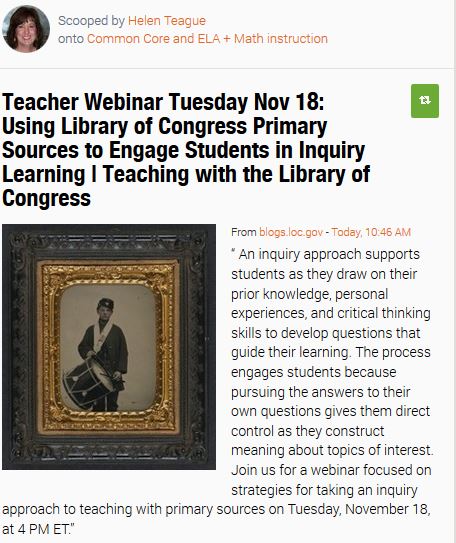News for Teachers: Second Online Conference October 25th and 26th
Library Hosts Online Conference for Educators
As the new school year gets into full swing, the Library of Congress will bring teachers and education experts from across the nation together in its second annual online conference for educators. This free two-day event, “Discover and Explore with Library of Congress Primary Sources,” will be held October 25-26, from 4-8 p.m. EDT and will be open to K-12 educators from across all teaching disciplines. Last year’s event brought together more than 1,500 participants for the sessions.
Over the course of two days, there will be 15 one-hour sessions facilitated by Library specialists, instructional experts from the Library’s Teaching with Primary Sources Consortium and other recognized K-12 leaders. Session topics will range from assessments and literacy to historical newspapers and kindergarten historians, and all sessions will focus on the effective use of Library of Congress primary-source documents.
According to Lee Ann Potter, director of educational outreach at the Library, “Primary sources can capture student attention, and by analyzing them, students can engage with complex content, build their critical-thinking skills and create new knowledge. The Library’s online conference for educators will allow teachers to learn how to access Library of Congress resources and to discover new strategies for integrating primary sources into their instruction.”
Highlights of the conference:
The keynote speaker will be the award-winning author Tonya Bolden, who will discuss her process of research for writing children’s books about historical figures.
Library experts will include specialists from the Chronicling America historical newspaper archives, the historian of the Library of Congress, professionals from the educational outreach division, and more.
Other presenters will include Joel Breakstone from Stanford University, Dan Rothstein of the Right Question Institute, and Kelly Schrum of the Center of History and New Media.
After the live online conference, the Library will make recordings of all sessions available to the public on its website for teachers, loc.gov/teachers/. Teachers will be able to earn up to 15 hours of CEU/PDU by participating or viewing online conference sessions, and certificates will be available for completing each session.
Register for the conference: www.loc.gov/teachers/professionaldevelopment/webinar/online-conference-2016.html?rssloc=eanft





